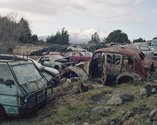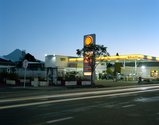Peter Ireland – 12 March, 2013
The book's - and exhibition's - subtitle “Views from the Peak?” has a double meaning. The “Peak” refers to oil reserves with the question mark hovering over the reserves/production issue, but there are also geographic peaks featuring in the images: Taranaki, Paritutu, Ruapehu and those craggy utterances surrounding the entrance to Whangarei Harbour.
The dynamic of the art world’s operation is a complex and socially fascinating mechanism, the elegant mahogany veneer successfully masking the lump of plain particle board supporting it, the smoothness of the veneer at odds with the often toxic elements binding together the rougher chips beneath. Part of this masonic-like underworld is a reluctance to admit the part fashions play in the seemingly endless round of auctions, exhibitions and related events. A human desire for novelty is an enduring characteristic of the species, and is yet another socially fascinating mechanism well worth studying. Factors such as warding off boredom and keeping up with the Joneses are all part of the mix. In the art world, along with the reluctance to discuss fashions, there’s a hesitancy about admitting the probably enormous part peer-group dynamics play in the formation of private collections.
Until very recently the photographic medium was absent from such private art collections. Of course, there were private collections of photography, but they were formed almost uniquely by photographers and their few camp followers, many of them deeply suspicious of the perceived elitism around collecting art. So, even as recently as two decades ago, photography was not fashionable. Now it is. But only on the art world’s terms. The socially fascinating description “art photography” implies a distinction between images acceptable to art collectors and those not. Parallel lists might be made, but such an exercise would be unkind, and certainly too much fun.
Photography on photography’s terms has always had an intrinsic connection with what’s called the documentary tradition. Given the classification mania of the mid-19th century when the medium was invented (both scientific and populist), photography was God’s gift to this process: it was the perfect tool for registering the common and the exotic, the local and the foreign, for documenting the physical facts of the world. Along with scientific need there was a political development - particularly in those countries where photography first took root - a rising instance of effective democracy, since stigmatised as socialism. This unlikely pairing of science and politics produced the phenomenon of “the concerned photographer”, practitioners who used the medium in a largely unconcerned social climate vis a vis the powerful to bring attention to various social ills. What now may constitute “documentary” has been the subject of much discussion since the 1980s, but these ongoing speculations have never quite dismissed the perhaps pivotal point of the tradition - that of a complaint to the powerful about the powerless.
It’s possible that this crusading focus was one of the reasons why photography just couldn’t be considered as art. The medium’s own effort in the 1880s to enter this pantheon, the movement known as Pictorialism, was completely at right angles to anything the documentary enterprise attempted. Once stigmatised as dishonest, Pictorialism aped the art conventions of the day, using soft-focus manipulations later trashed by its beit noir, Modernism, which in its purist agenda valued only “truth to materials”, not any mucking around with the focus and using gimcrack printing methods. Modernism also came down hard on anything political (Picasso’s Guernica was The Great Exception because it was cool to be on the Republican side in the Spanish civil war), writing it off as “propaganda”, so the documentary tradition got side-lined there too. But, the main problem was - and remains - the fact that the art collectors also tend to be the powerful, and part of their power is, firstly, to choose what they take notice of, and secondly, to determine by their choices what is to be valued as art. The classic double whammy.
So, even though photography has broken through the art collecting barrier, there remains an unbreached resistance to anything tainted by documentary - unless it’s, say, the socially tepid work of the nevertheless crusading Laurence Aberhart, the bleak, but subversive landscapes by the truly passionate Mark Adams, or perception-shattering double images by the detective Ann Shelton. But once you start straying into territory occupied by, say again, Wayne Barrar, early Bruce Connew, Fergus Cunningham or Peter Evans, you start getting into trouble.
The subject of Evans’ latest project is the current oil and natural gas industry landscape of New Zealand. The questions this raises are not likely to bring comfort to anyone seriously into conspicuous consumption, and despite the cruel beauty of his images, he’s pretty much ruling himself out from the determined art collecting scenario. Whatever his good intentions might be, the ruling corporate model does not welcome any degree of critical analysis that might impact negatively on its ability to make a profit. But Evans’ work brings comfort to anyone interested in photography, if only for him sticking to his guns. There’s much more to it than that though.
The eight images comprising the McNamara show are among 18 published in a 48-page booklet accompanying the exhibition. There’s an introductory essay by the photographer in which he states “I do not intend for the photographs that comprise this exhibition to be an illustration of the issues raised over the next several pages, however I think it is useful for the viewer to understand my inner concerns of a global nature to fully appreciate my more localised creative ambition”. This is preceded by a somewhat more earnest apologia: “The oil industry is a hot topic in New Zealand at the moment, and presents highly political, economic and environmental issues, which will unfold over the coming years. My intent in photographing the oil and gas industry in New Zealand is certainly not to attack the industry, which would be hypocritical as I like all other New Zealanders are dependent upon the industry within the landscape. In fact on the contrary, I would like to openly thank those in the industry for giving me privileged access to in many cases restricted sites that have made this exhibition possible. I personally burnt thousands of dollars in fossil fuels, travelling around New Zealand with the purpose of photographing the industry”.
The book’s - and exhibition’s - subtitle “Views from the Peak?” has a double meaning. The “Peak” refers to oil reserves with the question mark hovering over the reserves/production issue, but there are also geographic peaks featuring in the images: Taranaki, Paritutu, Ruapehu and those craggy utterances surrounding the entrance to Whangarei Harbour. The reproductions are followed by another essay Peak Oil and Implications for NZ by Bob Lloyd of Otago University’s physics department, a technical but readable and relevant account that soberly and clearly outlines the situation.
Evans’ earlier work has revolved around “the landscape”, those quotation marks necessarily signalling his particular take. “The New Zealand Landscape”, oh where do you start? The subject is so freighted with history, so shaped by longing, so weighed down with guilt, so riven by contention it would take several volumes to untangle the skein. It’s almost impossible to see it, consider it, outside the lens of the Picturesque, that 18th century device which packaged it up for our delectation, providing a handy set of aesthetic blinkers allowing rape and pillage with self-congratulation and without remorse. Evans’ particular take is consistently anti-Picturesque to the point (which is the point) that viewers may wonder why the image was made. If you think Brian Brake’s a great photographer then you’ll have good reason to wonder about Evans.
Since his last show at McNamara’s this photographer, like so many, has opted for a larger print size. This general drift is partly fashion, partly a device to elbow one’s place to greater visibility on already crowded gallery walls. In many cases bigger works are just shouting “Hey!” With Evans, though, it’s a practical response to the nature of his photography. His former sparse imagery has become more beefed up by detail, and these undoubtedly handsome prints do their content justice.
The “unspoilt wilderness” approach does not figure in Evans’ lexicon. His beliefs don’t stretch to the old division of town and country - urban and rural, here and there - knowing there is no part of New Zealand left unmodified in some way by human activity. His images invariably register some mark of human intervention, visual stabs in the dis-eased body of Romanticism. His work stands somewhere on the spectrum between Wayne Barrar’s altered landscapes and Natalie Robertson’s current marae project, all of them focusing on aspects of environmentalism as the new social challenge for the documentary tradition.
He’s not entirely free of nods towards the Sublime though. The final photograph in the book - one also in the McNamara show - is an aerial view of a cloud-wreathed Mt Taranaki from far out to sea, and down below, tiny by comparison, is a huge wellhead platform in the Kupe natural gas field, an image updating Caspar David Friedrich’s classic icons of foreground figures contemplating Nature. Evans’ dumb structure is more comment than contemplation, leaving us the viewers to do the math. Right now, at the beginning of the 21st century, not much is adding up. It’s fashion versus future.
Peter Ireland
Recent Comments
Paul Gilbert
Photographers like young Peter Evans and most of the other photographers mentioned in this commentary, are working well beyond the ...








 Advertising in this column
Advertising in this column Two Rooms presents a program of residencies and projects
Two Rooms presents a program of residencies and projects



This Discussion has 1 comment.
Comment
Paul Gilbert, 2:06 p.m. 16 March, 2013 #
Photographers like young Peter Evans and most of the other photographers mentioned in this commentary, are working well beyond the gratification of those on a wee trip to the white cube for the lunchtime browse.
As practitioners, cobbled together here, as socially tepid,truly passionate,or perception shattering, I feel the reviewer is , if entertainingly, consigning some of our most committed photographers to the lower stock drawer of the day.
That they have made a fundamental identification of and commitment to personally and socially worthy long term projects, is setting a course of finely navigated and recorded revelation that will outlast the fashionable repitition of saleable bling.
I have long believed that setting such a course, mining a seam with its constant propping, ventilating, removal of tailings, and scratching at the mined face, lead to detailed and multi layered understanding of what glints bright in the lenses eye.
This is a good strategy, if not for putting bread on the table or fossil fuel in the transport as pointed out, but as a metronome who's sound will carry forward. They are engraving the archeology of tommorrow that allows a position to stand, to view our continuum.
If corporate sensibilities are afronted by such flinty vision then it behoves the larger art instutions to not blow their budgets on huge single examples of "famous" overseas works, but to collect and suport serious local photography, and put locally sourced and sustainable gas into the tank.
Participate
Register to Participate.
Sign in
Sign in to an existing account.